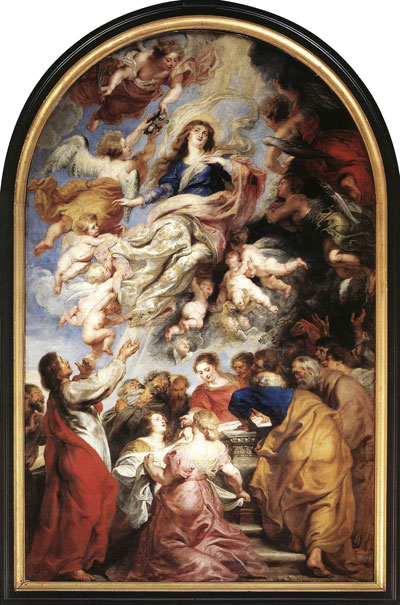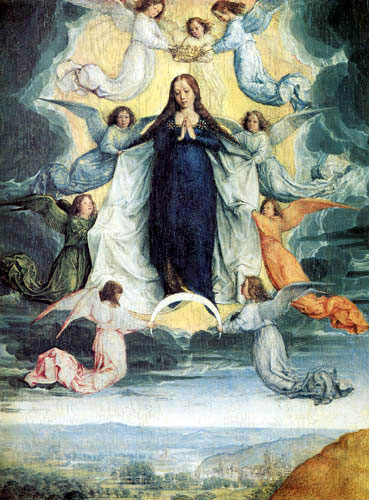
The Assumption of Mary
The Assumption of Mary is the traditional belief held by Christians of the Roman Catholic, Eastern Orthodox, Oriental Orthodox, Anglo-Catholic, and some Protestant churches that the Virgin Mary at the end of her life was physically taken up into heaven. The Roman Catholic Church teaches as dogma that the Virgin Mary, “having completed the course of her earthly life, was assumed body and soul into heavenly glory.” This means that it claims that Mary was transported into Heaven with her body and soul united. This doctrine was dogmatically and infallibly defined by Pope Pius XII on November 1, 1950, in his Apostolic Constitution Munificentissimus Deus. The feast day recognizing Mary’s assumed passage into Heaven is celebrated as The Solemnity of the Assumption of the Blessed Virgin Mary by Roman Catholics, and as the Dormition by Orthodox Christians. In those denominations that observe it, the Assumption is a major festival, commonly celebrated on August 15. This is a Holy Day of Obligation in many Roman Catholic jurisdictions.
In his August 15, 2004, homily given at Lourdes, Pope John Paul II quoted John 14:3 from the Bible as a scriptural basis for understanding the dogma of the Assumption of Mary. In this verse, Jesus tells his disciples at the Last Supper,
- “If I go and prepare a place for you, I will come again, and will receive you to myself; that where I am, you may be there also.”
According to Catholic theology, Mary is the pledge of the fulfillment of Christ’s promise. However, many theologians disagree with this interpretation of Scripture, and believe that Christ was speaking about his preparation of Calvary and the crucifixion for the remission of sins.

Although the Assumption (Latin: assūmptiō, “taken up”) was only relatively recently defined as infallible dogma by the Catholic Church, and in spite of a statement by Epiphanius of Salamis in AD 377 that no one knew of the eventual fate of Mary, apocryphal accounts of the assumption of Mary into heaven have circulated since the 5th century. The Roman Catholic Church itself interprets chapter 12 of the Book of Revelation as referring to it. The earliest known narrative is the so-called Liber Requiei Mariae (The Book of Mary’s Repose), a narrative which survives intact only in an Ethiopic translation. Probably composed by the 4th century, this early Christian apocryphal narrative may be as early as the 3rd century. Also quite early are the very different traditions of the “Six Books” Dormition narratives. The earliest versions of this apocryphon are preserved by several Syriac manuscripts of the 5th and 6th centuries, although the text itself probably belongs to the 4th century.
Later apocrypha based on these earlier texts include the De Obitu S. Dominae, attributed to St. John, a work probably from around the turn of the 6th century that is a summary of the “Six Books” narrative. The story also appears in De Transitu Virginis, a late 5th century work ascribed to St. Melito of Sardis that presents a theologically redacted summary of the traditions in the Liber Requiei Mariae. The Transitus Mariae tells the story of the apostles being transported by white clouds to the deathbed of Mary, each from the town where he was preaching at the hour. The Decretum Gelasianum in the 490s declared some transitus Mariae literature apocryphal.
n Armenian letter attributed to Dionysus the Areopagite also mentions the event, although this is a much later work, written sometime after the 6th century. John of Damascus, from this period, is the first church authority to advocate the doctrine under his own name; he had been brought up in an environment in which a corporeal ascent of Muhammed into heaven was official policy, since he, and his father before him, held the post of imperial chancellor of the Islamic empire of the Umayyads, and Muhammed’s ascent into heaven is the subject of the Night Journey, a Surah in the Quran. His contemporaries, Gregory of Tours and Modestus of Jerusalem, helped promote the concept to the wider church.
In some versions of the story the event is said to have taken place in Ephesus, in the House of the Virgin Mary, although this is a much more recent and localized tradition. The earliest traditions all locate the end of Mary’s life in Jerusalem (see “Mary’s Tomb”). By the 7th century a variation emerged, according to which one of the apostles, often identified as St Thomas, was not present at the death of Mary, but his late arrival precipitates a reopening of Mary’s tomb, which is found to be empty except for her grave clothes. In a later tradition, Mary drops her girdle down to the apostle from heaven as testament to the event. This incident is depicted in many later paintings of the Assumption.
The assumed taking of Mary into Heaven became an established teaching across the Eastern, Western, Coptic and Oriental churches from at least the late 7th Century, the festival date settling at August 15. Theological debate about the Assumption continued, following the Reformation, climaxing in 1950 when Pope Pius XII defined it as dogma for the Roman Catholic Church. The Roman Catholic Church has not claimed that this doctrine is founded on the apocryphal accounts as having any authority, nor that the church bases its teaching about the Assumption on them, but rather on the historic teaching of the Church down the centuries, the scholastic arguments in favor of it, and its interpretations of biblical sources.
However, Protestant theologians reject such arguments as semantics; that apocryphal accounts did in fact become the basis for such church teachings, which were then set forth as dogma. They cite the fact that the idea did not gain acceptance in the church until the sixth century, after Gregory of Tours accepted the apocryphal work “Transitus Beatae Mariae”. Indeed Roman Catholic theologian Ludwig Ott stated, “The idea of the bodily assumption of Mary is first expressed in certain transitus–narratives of the fifth and sixth centuries…. The first Church author to speak of the bodily ascension of Mary, in association with an apocryphal transitus B.M.V., is St. Gregory of Tours.” The Roman Catholic writer Eamon Duffy goes further, conceding that “there is, clearly, no historical evidence whatever for it.”. However, the Roman Catholic Church has never asserted nor denied that its teaching is based on the apocryphal accounts. The Church documents are silent on this matter and instead rely upon other sources and arguments as the basis for the doctrine.
The Assumption in Roman Catholic teaching
In this dogmatic statement, the phrase “having completed the course of her earthly life,” leaves open the question of whether the Virgin Mary died before her Assumption, or, whether she was assumed before death; both possibilities are allowed. Mary’s Assumption is said to have been a divine gift to Mary as ‘Mother of God’. Ludwig Ott’s view is that, as Mary completed her life as a shining example to the human race, the perspective of the gift of assumption is offered to the whole human race.
In Ludwig Ott’s Fundamentals of Catholic Dogma he states that “the fact of her death is almost generally accepted by the Fathers and Theologians, and is expressly affirmed in the Liturgy of the Church,” to which he adduces a number of helpful citations, and concludes that “for Mary, death, in consequence of her freedom from original sin and from personal sin, was not a consequence of punishment of sin. However, it seems fitting that Mary’s body, which was by nature mortal, should be, in conformity with that of her Divine Son, subject to the general law of death”. The point of her bodily death has not been infallibly defined, and many believe that she did not die at all, but was assumed directly into Heaven. Indeed, the papal decree which, according to Roman Catholic dogma, infallibly proclaims the doctrine of the Assumption, the Apostolic Constitution Munificentissimus Deus, leaves open the question whether, in connection with her departure, Mary underwent bodily death; that is, it does not dogmatically define the point one way or the other, as shown by the words “having completed the course of her earthly life”.
On November 1, 1950, Pope Pius XII solemnly declared:
- By the authority of our Lord Jesus Christ, of the Blessed Apostles Peter and Paul, and by our own authority, we pronounce, declare, and define it to be a divinely revealed dogma: that the Immaculate Mother of God, the ever Virgin Mary, having completed the course of her earthly life, was assumed body and soul into heavenly glory
Since the declaration of Papal Infallibility by Vatican I in 1870, this declaration by Pius XII has been the only ex cathedra use of Papal Infallibility. While the then Pope Pius XII deliberately left open the question of whether Mary died before her Assumption, the more common teaching of the early Fathers is that she did.
The Virgin Mary’s heavenly birthday
The Assumption is important to many Catholic and Orthodox Christians as the Virgin Mary’s heavenly birthday (the day that Mary was received into Heaven). Her acceptance into the glory of Heaven is seen by them as the symbol of the promise made by Jesus to all enduring Christians that they too will be received into paradise. The Assumption of Mary is symbolised in the Fleur-de-lys Madonna.
Before the Roman Catholic Church came into existence, however, the day of August 15 was celebrated in the Roman Empire to honor the gods, in particular Diana, and the cycle of fertility and ripening. In fact, the present Italian name of the holiday, “Ferragosto”, derives from its original Latin name, Feriae Augusti (“Holidays of the Emperor Augustus”), and even the entire month took its name from the emperor. The holiday was related to a celebration of the middle of the summer and the end of the hard labour in the fields. In time, Roman Catholicism adopted this date as a Holy Day of Obligation to commemorate the Assumption of the Blessed Virgin Mary, the real physical elevation of her sinless soul and incorrupt body into Heaven.
The Feast of the Assumption on August 15th is a Public Holiday in many countries, including Andorra, Austria, Belgium, Bosnia, Burundi, Cameroon, Central African Republic, Chile, Republic of Congo, Cote d’Ivoire, Croatia, Colombia, Cyprus, East Timor, France, Gabon, Greece, Republic of Guinea, Haiti, Italy, Lebanon, Lithuania, Luxembourg, Macedonia, Madagascar, Malta, Mauritius, Monaco, Paraguay, Poland, Portugal, Rwanda, Senegal, Seychelles, Slovenia, Spain, Switzerland, Tahiti, Togo, and Vanuatu.
It is also a holiday in some predominantly Catholic states of Germany, including Bavaria and Saarland. In Guatemala it is observed in Guatemala City and in the town of Santa Maria Nebaj, both of which claim her as their patron saint.
Also, this day is combined with Mother’s Day in Costa Rica. In many places, religious parades and popular festivals are held to celebrate this day. Prominent Catholic and Orthodox countries in which Assumption day is an important festival but is not recognized by the state as a public holiday include Argentina, Brazil, Czech Republic, Ireland, Mexico, the Philippines and Russia. In Canada Assumption Day is the Fête Nationale of the Acadians, of whom she is the patron saint. Businesses close on that day in heavily francophone parts of New Brunswick, Canada.
The Virgin Assumed in Heaven is also patroness of the Maltese Islands and her feast, celebrated on 15 August, apart from being a public holiday in Malta is also celebrated with great solemnity in all the local churches especially in the seven localities known as the Seba’ Santa Marijiet. In Anglicanism and Lutheranism, the feast is kept, but without official use of the word “Assumption”. In New York City, alternate side of the street parking rules are suspended.
Source Wikipedia




